Pop-Up Globe, Entertainment Quarter. Pop-up Globe Southampton’s Company.
Not reviewed.
Midnight Feast. Sydney Opera House. Nov 29 & 30, 2018
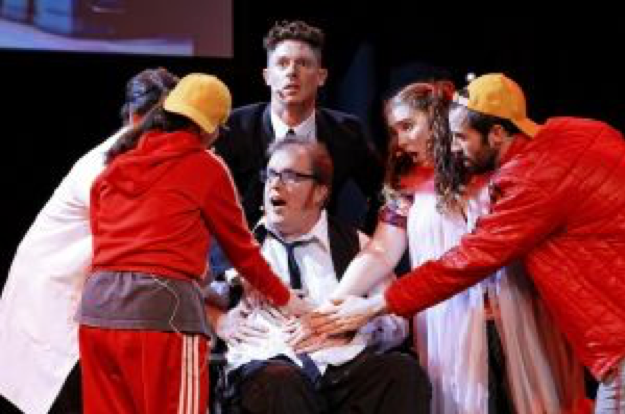
In the battle for inclusion, no group has to fight more strongly than those who are challenged physically, intellectually and emotionally – and the people who love them. Two weeks in a row I have seen that that ‘fight’ manifested gloriously in two of the biggest performance spaces in Sydney.
Last night in the Studio at the Opera House twenty-six excited and diversely ‘challenged’ performers from the inclusive company, Midnight Feast, combined their funny and beautiful stories and dreams in a performance entitled Fireside. The buzz from the stage was exhilarating as they celebrated “abilities rather than limitations”. The buzz from the audience of proud parents and supporters was just as uplifting.
“The future, my darlings, is bright and inclusive”.
The struggle to be included across all aspects of society is hard enough. In the Arts it is even harder. Kylie Harris, founder and artistic director of Midnight Feast, explains that:
… some communities are left out of our main stages and screens. If they are represented it is tokenism or an off-handed reference for diversity’s sake, but the lived experience of any human being is equally valid and equally worthy of celebration …
‘Celebrate’ was the key word of Midnight Feast’s performance last night as Fireside took its performers on a journey to find a Willy Wonka-style ‘Golden Ticket’ to see their dreams come true.
By sharing those dreams and their stories – with Harris, Drs Stephen Sewell (Head of Writing for Performance, NIDA) and Suzanne Osmond (Acting Head of Cultural Leadership, NIDA) and a dedicated team of carers and creatives – these enthusiastic and committed performers developed a production that told of their different journeys, the things they hate, the mistakes they made, and the many things they want to do.
They did so as they were ‘abducted’ by a group of Aliens in a spaceship that eventually broke down and no one knew how to fix. Lights flashed, doors opened and shut on a screen above them. Escape seemed impossible until Heath Ramsey, as Edward St John, suggested they escape to their Happy Places – one of which involved a group of Brazilian Fantasy Dancers.
From those Happy Places they found the key to escape was … INCLUSION … and the stimulation and invigoration it can bring. They celebrated accordingly.
The excitement and elation of this proud group of performers – and their opening night audience – was inspiring, as was their confidence, dignity and honesty as they answered questions from the audience.
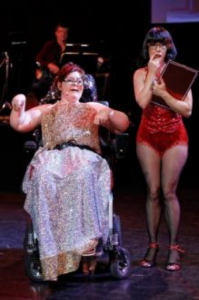
Kylie Harris’ face shone with pride as she passed the microphone from one excited performer to another – and as she announced that NIDA is investing in fully inclusive facilities, so that the company can keep working there as it “explores humanity in all its diversity and challenges assumptions”.
This is a production that shows just what can be achieved when kindness and respect, confidence and conviction, belief and hope overcome prejudices and preconceptions, injustices and intolerance. As Miss First Nation Drag Queen, Josie Baker (alias Joseph Cardona) exalted the cast in the rousing finale “The future, my darlings, is bright and inclusive”.
Also published in Stage Whispers magazine
By Rachael Coopes. Riverside and Bathurst Memorial Entertainment Centre in association with Australian Theatre for Young People. Riverside Theatres, Parramatta. Nov 22 – 24, 2018.
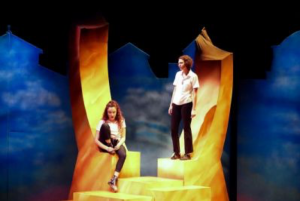
Bathurst was the first ‘inland city’ established by the white settlers who followed Blaxland, Lawson, Wentworth and their Aboriginal guides over the Blue Mountains in 1813. On the land of the Wiradyuri people, they established a settlement that would become a beacon to the west. But in this process, they ‘highjacked’ and destroyed aboriginal sacred sites and burial grounds.
In The Climbing Tree, Rachael Coopes has documented four years of workshops and research into a play that gathers together what director Stephen Champion describes as “the thematic threads and heart” that tell the “essential stories of Bathurst”. It is a moving history that tells of ancient legends and old tragedies alongside contemporary issues and protests. In the hands of four gifted performers, a multi-talented musician and an empathetic director, it is a story that reveals not only “the essence of Bathurst” but of Australia itself.
They have an essence of Bathurst in them with much broader resonance and we hope to share them widely”. I echo that hope.
With the sound of the 35 bells of the Carillon punctuating the dialogue, their modern-day problems echo issues of the past – a convict servant’s concern about falling in love with her master’s son; the public flogging of the convict Ralph Entwhistle for skinny dipping in 1839; his subsequent hanging with nine other bushrangers in 1830; and the mistreatment of European migrants.
The stories transition via sound effects and the voice of “authority” operated and performed by Tim Hanson, who influences the changes in pace and atmosphere of the performance. Lighting by Bannon Rees helps shift time, place and prevailing mood.
There is a certain type of energy required to portray teenagers and all four actors find it convincingly. Peppered with the idiom and humour that Coopes has injected into the dialogue and the variation in pace Champion has directed, their appeal to both young and old audience members is electric.
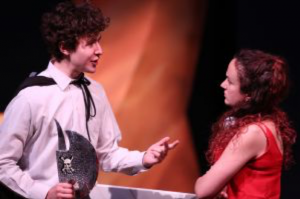
Madelaine Osborn is beautifully believable as the rebellious but bright Rayleen, who, despite carrying the burden of an addicted mother, a young sister and unsympathetic schoolteachers, is lively, cheeky, funny and caring.
Jayla-Shae Davey plays her best friend, but complete opposite, Kylie. Davey portrays the different dimensions in Kylie’s character – her desire or justice and reconciliation, her ambition to lead but lack of belief in herself and the calming effect she usually has on. . . .
Review continued in Stage Whispers magazine.
Noëlle Janaczewska is an Australian playwright, poet and essayist who specialises in writing about people and events that “have been overlooked or marginalised in official records”. In this play she has taken as her inspiration the history of Penrith Regional Gallery & The Lewers Bequest and through it “traces the roots of Sydney’s early Modernist thinking and offers a fresh take on Emu Plains in the 1950s”.
In the 1940s, Gerald and Margot Lewers, leading artists in the development of modernism in Australia, bought a property at the foot of the Blue Mountains. Their home became a mecca for the creative cohort of the time. Patrick White described it as a place where “ideas hurtled, argument flared, voices shouted, sparks flew”. After Margot’s death in 1978, the house, gardens and many of the artworks were bequeathed to the local community. Thus, the Penrith Regional Gallery was born.
There is much in this play that inspires thought and discussion. Hopefully it will be one that goes on to reach a larger audience.
Janaczewska sets the play in the kitchen of the artists’ home, where the ‘hired help’, Iris and Leo, prepare food for a party that occurs off stage. As guests arrive they collect coats and serve hors d oeuvres – their own lives and conversations a stark contrast to the more bohemian visitors and their heady discussions. Janaczewska accentuates the time with quotations on the food and etiquette of the time that appear on the ‘kitchen’ wall – much to the quiet amusement of the audience.
Katja Handt’s set places the play perfectly. Food is prepared at a scrubbed table, curtains cover some of the cupboards, a large washing up basin dominates the bench space. My grandmothers’ kitchens have been recreated on the stage! With walls, furniture and appliances etched in charcoal-like shading, the kitchen is like the set of a 1950s black and white TV program.
As is Nick Atkins’ direction. There is a sense of the past in the blocking, a past where people knew their place but were aware of changes that were coming. Actions are precisely modulated, the characters obviously discussed and developed with care and the cadences of Janaczewska’s poetic dialogue skilfully rehearsed.
Kate Worsley is beguiling as Iris, a twenty-year-old finding her place in a society that is still affected by post war economies and definite ideas about ‘a woman’s place’. She cleverly finds the suggestion of questioning and awareness of new ideas that Janaczewska has woven into the script, making her Iris a little bit bold and forward thinking.
As Leo, a Biology teacher new to Australia from Hungary, Adam Booth is convincingly reticent, but also direct. He chops and fries field mushrooms as precisely as he avoids giving away too much of his opinions or his real feelings about Australia’s failure to recognise his teaching qualification.
On the stage beside them, cellist Me-Lee Hay deftly accompanies the action, sometimes subtly, at others more obtrusively as scenes become more agitated, dialogue more intense.
There is much in this play that inspires thought and discussion. Hopefully it will be one that goes on to reach a larger audience.
Also published in Stage Whispers magazine.
Adapted by Steve Rodgers from the novella by Peter Goldsworthy. National Theatre of Parramatta. Riverside Theatres Parramatta. October 18- 27, 2018.
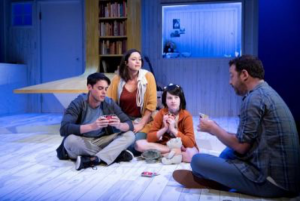
Playwright Steve Rodgers, who adapted this story by Peter Goldsworthy for the stage, says this play “is about love and grief”. Director Darren Yap describes it as a “deeply moving story … full of pain and full of love, where family is everything.” It is all of this – and more – and, as such, it is a play that requires tenderness and understanding, sensitivity and compassion.
Rodgers met this requirement in his loving treatment of the story and the characters who tell it. Yap meets it with delicate perception in his direction. The cast bring it gently and intuitively to life. It is a touching, true-to-life production that demands an emotional commitment that is not usually expected from live theatre.
To say too much about the plot would be unfair to those who have worked so intensely to bring it to the stage. It is important, though, to say it is confronting in its intensity, challenging in its complexity.
. . .his closely bound cast brings Rodgers’ confronting but beautiful play into intense reality . . .
Both Jackson and Smith are compellingly authentic – in the brief but very poignant opening scene where they first realise the depth of their love – then as that love grows to envelop their children. Both find the emotional strength and complexity of these multi-faceted characters that Rodgers has shaped through sparse dialogue that suggests so much. These are not easy characters to play, but they so with deep insight and empathy.
Grace Truman brings surprising depth and awareness to the role of ‘Wol’. It is not an easy role and . . . .
Review continued in Stage Whispers magazine
by Joe Orton. New Theatre, Sydney. Oct 2 – Nov 3, 2018.
Director Danielle Mass has brought Orton’s provocative attack on hypocrisy somersaulting into 2018 with her cunning cross casting and precision-based direction. She has swept together the farce and the facetious in a production that heightens Orton’s comic genius – and the contemporary relevance of the inequalities that he satirised so subversively … and so well.
The play opens with Dr. Prentice, a psychiatrist, trying to seduce a prospective secretary, Geraldine Barclay, in a job interview. When his wife enters, he attempts to cover up his activity by hiding the girl behind a curtain. But his wife, who is being blackmailed by Nicholas Beckett, promises Nicholas the post as secretary. Add to this confusion, a self-serving government inspector, Dr Rance, a police sergeant, lots of costume exchanges, drugs, alcohol, lust, nudity and a panto-like ending – and you have what New Theatre adroitly advertises as: “this darkest of farces, stuffed full of twists and turns, mishaps and changes of fortune, coincidences and lunatic logic in which six characters gradually lose the plot, their wits and/or their clothes”.
The chaos thus described is accentuated by the sleek realism of production designer Tobias Manderson-Galvin’s set. Cool green and stark white; clean lines and sharp edges; and an obligatory sky-light invoke the institutional reality of the clinic. Careful construction ensures no slamming door causes a wall to shudder. The set is stable and secure – despite the fact that what happens on it is anything but.
Maas and her cast have honed this production to emphasise the qualities that make farce … well … farcical. It is fast-moving and fast-talking. The actors pose and posture with hilarious precision, and – because of the casting – in doing so add layers of innuendo and dimension to the characters and the plot.
Ariadne Sgouros is Dr Prentice. With tight-lipped, ‘upper class’ drawl and quizzical expression, Sgouros makes this role as falsely straight as Orton might have wished – and a perfect contrast to the posturing elegance and contained physicality of Jake Fryer-Hornsby as Mrs Prentice. Together they pace and pose, emphasisng the satire, and pulling off some cleverly timed gags involving bottle-opening, flowers and a brief case.
Amrik Tumber plays the interfering Dr Rance with bold aplomb.. . .
Review continued at Stage Whispers magazine.
Independent Theatre, North Sydney; Sunday 31st September 2018
 Eight members of the Metropolitan Orchestra (TMO) sneaked away from the mainstream yesterday to ‘wow’ an already expectant audience in a very special ‘gig’. From Bach to Led Zeppelin, Ravel to Metallica, they showed the mellow versatility of this lowest-pitched, second-largest stringed instrument.
Eight members of the Metropolitan Orchestra (TMO) sneaked away from the mainstream yesterday to ‘wow’ an already expectant audience in a very special ‘gig’. From Bach to Led Zeppelin, Ravel to Metallica, they showed the mellow versatility of this lowest-pitched, second-largest stringed instrument.
Introduced, tongue in cheek, by leader John Benz as “the most important part of the orchestra”, Ezmi Pepper, Caroline Hobbs, Paul Taylor, Steve Meyer, Zenith Chae, Nick McManus and Julienne Guerbois took the stage for an uninterrupted program beginning with two of American 20th century composer Brian Kelly’s Spanish compositions. The first ,a short atmospheric piece, provided a fitting introduction to the second which conjured the busy bustle of a village market. Motifs intertwined, slow over fast, as the musical interpretation of the scene unfolded.
From Kelly, they moved to JS Bach and Rousseau, their baroque compositions showcasing the depth and flexibility of this instrument, the moods it can inspire, and the energy and emotional concentration it demands of those who play it, whether it be the quiet, pensive final notes of Rousseau or something more upbeat … like Led Zeppelin’s 1975 classic rock hit, Kashmir, where the faster pace, taut pauses and climactic crescendo highlighted the amazing adaptability of the instrument and the musicians.
From ‘heavy’ Rock they moved on to Ravel’ gentle Pavane for a Dead Princess. Here the melancholy of the cello was most evident, the softer, more intense notes merging tenderly with the whisper of the plucked strings.
Shostakovich’s waltz, Suite for Variety Orchestra raised the tempo again – and beautifully demonstrated the various voices of the cellos, the lovely interaction between the performers, and their obvious joy in this stirring mid-twentieth century tribute to waltz-time.
Less cheerful was Wagner’s Pilgrim’s Chorus from the opera, Tannhauser, but this too showcased the emotional control required to create the poignant images and tension in this song where penitent pilgrims praise the peace of God’s mercy.
A little different were the musical messages in Metallica’s 1991 hit, Nothing Else Matters, which once again emphasised the energy of the musicians – and their control, especially in the last lingering notes.
Percussive tapping set the pace for the final item in the program, a tango by Argentinian composer by Astor Izola, the cello a perfect instrument to invoke the sultry atmosphere and precision movement of the dance.
Called back to the stage twice, the group performed a bopping little piece composed by the group’s own Caroline Hobbs – and a rocking reprise of Kasmir that left the audience asking for even more.
The next concert by the Metropolitan Orchestra will include Elgar’s Cello Concerto, featuring a solo by Ezmi Pepper. Sarah-Grace Williams will conduct the concert on Saturday 27th October in the Eugene Goosens Hall at the ABC Centre, Ultimo. Check TMO’s website for information and availability of tickets.
By Arnold Ridley. Genesian Theatre, Kent Street, Sydney. September 22 – October 28, 2018.
You may remember Arnold Ridley as Private Godfrey, the gentle, old medic in the British comedy series Dad’s Army, but as well as an actor, he was also a prolific playwright. Of his 19 plays, the best known is The Ghost Train, written in 1923 after Ridley was stranded overnight during a rail journey through Gloucestershire. The play has a long history. Its initial production ran to sell out houses at St Martin’s Theatre from 1925 to 1927. It has been adapted for many film versions, the first a silent film in 1927. An audio version of the play was recorded as late as 2010.
Why? Because it’s a great example of a comedy suspense thriller! And director Stephen Lloyd-Coombs, with his Genesian cast and crew, have really done it justice. His production highlights the melodramatic aspects of the writing by focusing on the ‘stock’ nature of the characters and the use of timing, pace, pause, freezes, vocals, tableaux and innuendo. For anyone studying melodrama – or anyone who values precision acting – it’s a must see.
Stephen Lloyd-Coombs has given this ninety five year old classic the energy and panache it deserves. It’s fun, entertaining and beautifully performed.
The play is set in the waiting room of an isolated railway station, where a diverse group of travellers are stranded for the night. Though the station master tries to persuade them to leave, there is nowhere for them to go, so they decide to stay, despite his warning that the ghost of a train wrecked in the area sometimes haunts the line – killing anyone who sees it. Naturally, this leads to a variety of dramatic incidents – and revelations – as well as the climaxes and anti-climaxes one expects of a comic thriller.
Designer Ash Bell has given attention to detail in both her costumes and set. The costumes feature the colours and elegance of the 1920s – and the characters wear them with style. The dusty railway station waiting room in which they are trapped typifies the period, with slatted wooden seats, frosted windows, all very brown and dingy. Michael Schell accentuates this with eerie lighting effects and the spooky rumbling approach of the ghostly train.
Mark Langham plays the station master … and a more sinister character. His station master is suitably frustrated and anxious to lock up and get home, his local burr a contrast to the upper-class accents of the stranded travellers. As the stranger who arrives later in the play – accompanied by his equally sinister off-sider, Dr Sterling, played by Elizabeth McGregor – he is menacing and threatening.
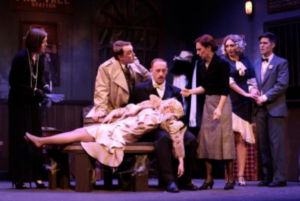 Zoe Crawford and John Willis-Richards are Elsie and Richard Winthrop, whose marriage is falling apart. She is a 1920s feminist, determined and . . . .
Zoe Crawford and John Willis-Richards are Elsie and Richard Winthrop, whose marriage is falling apart. She is a 1920s feminist, determined and . . . .
Review continued in Stage Whispers magazine
By Alan Ayckbourn. Castle Hill Players. Pavilion Theatre, Castle Hill Showground. September 21 – October 13, 2018.
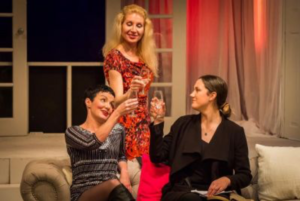 Staging a play that involves a hotel room in a 40-year time warp is obviously no problem for director, set and sound designer Bernard Teuben. With special lighting effects by Sean Churchward, he has transported Ayckbourn’s 1994 play into the 2038 suite of the Regal Hotel, London, complete with a frosted glass bathroom and a communicating door that, like a neon-lit Tardis, carries its passengers back to 2018 and 1998.
Staging a play that involves a hotel room in a 40-year time warp is obviously no problem for director, set and sound designer Bernard Teuben. With special lighting effects by Sean Churchward, he has transported Ayckbourn’s 1994 play into the 2038 suite of the Regal Hotel, London, complete with a frosted glass bathroom and a communicating door that, like a neon-lit Tardis, carries its passengers back to 2018 and 1998.
Filmy curtains surround the balcony windows, keeping out the dark of the London night as his well-rehearsed characters take this ‘comic-thriller’ through its paces. Elizabeth Chambers sparkles as the leather-clad dominatrix, Poopay, called to ‘minister’ to aging business man Reece (Stephen Snars). Reece, however, is not interested in her ‘services’. He merely wants her signature as witness to a confession to the murder of his wives by his partner, Julian (Steve Rowe), who hired Poopay!
In a tussle with Poopay, Reece collapses, Julian returns, they carry Reece into the bedroom, and Poopay realises that Julian is the murderer Reece has described. A chase ensues and Poopay runs through a communicating door to be carried back to 2018, where she meets Ruella (Margaret Moir), Reece’s second wife, the night before she is due to be thrown off the balcony by Julian. And that’s just the beginning!
Things get even more complicated when Ruella is time-warped to 1998 and tries to convince Reece’s first wife, Jessica (Jodie Klopf), on their wedding night, of her forth-coming murder. Hotel security man Harold Palmer (Larry Murphy) provides the typical Ayckbourn comic relief as the action gets faster and innuendos abound.
This is one of Ayckbourn’s more complex plays – and one where, as Teuben explains in his program notes, “the women are not the dim-witted, panic-stricken lasses often portrayed, but strong-willed characters taking chances and changing destinies.” A timely revival then!
Chambers is stunning in leather and boots, taking her character from posing prostitute to frightened victim, to concerned rewriter-of-history, in a confident, believable performance. Her pace and energy are integral to much of the action.
Snars ages carefully into the part of seventy-odd Reece, a bit stumbly, a bit shaky, but doggedly determined that the murderer be exposed. Where the character is 40 years younger – cavorting with Klopf . . . .
Review continued in Stage Whispers magazine